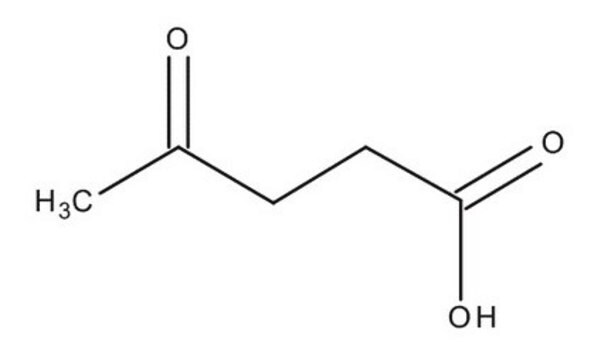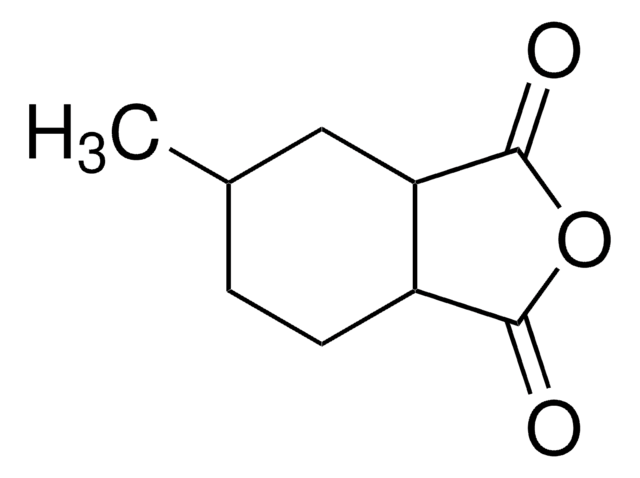W262701
Levulinic acid
natural, 99%, FG
Synonyme(s) :
4-Oxopentanoic acid, 4-Oxovaleric acid
About This Item
Produits recommandés
Qualité
FG
Fragrance grade
Halal
Kosher
natural
Agence
follows IFRA guidelines
meets purity specifications of JECFA
Conformité réglementaire
EU Regulation 1223/2009
EU Regulation 1334/2008 & 178/2002
Pression de vapeur
1 mmHg ( 102 °C)
Essai
99%
Caractéristiques du produit alternatif plus écologique
Less Hazardous Chemical Syntheses
Use of Renewable Feedstocks
Learn more about the Principles of Green Chemistry.
sustainability
Greener Alternative Product
Indice de réfraction
n20/D 1.442
pb
245-246 °C (lit.)
Pf
30-33 °C (lit.)
Densité
1.134 g/mL at 25 °C (lit.)
Application(s)
flavors and fragrances
Documentation
see Safety & Documentation for available documents
Allergène alimentaire
no known allergens
Allergène de parfum
no known allergens
Autre catégorie plus écologique
, , Aligned
Propriétés organoleptiques
caramel; creamy; acidic; sweet; vanilla
Chaîne SMILES
CC(=O)CCC(O)=O
InChI
1S/C5H8O3/c1-4(6)2-3-5(7)8/h2-3H2,1H3,(H,7,8)
Clé InChI
JOOXCMJARBKPKM-UHFFFAOYSA-N
Vous recherchez des produits similaires ? Visite Guide de comparaison des produits
Catégories apparentées
Description générale
Application
- Use of carboxymethyl cellulose as binder for the production of water-soluble catalysts.: Levulinic acid is used in conjunction with carboxymethyl cellulose to produce water-soluble catalysts. This application demonstrates the acid′s versatility in catalyst synthesis, enhancing the solubility and functionality of the resulting products (Paganelli et al., 2024).
- Nanocavity in hollow sandwiched catalysts as substrate regulator for boosting hydrodeoxygenation of biomass-derived carbonyl compounds.: This research explores the use of levulinic acid in biomass conversion processes. The study highlights the acid′s role in enhancing hydrodeoxygenation reactions, contributing to more efficient biofuel production (Zheng et al., 2024).
- Mechanism of CO(2) in promoting the hydrogenation of levulinic acid to γ-valerolactone catalyzed by RuCl(3) in aqueous solution.: This paper investigates the catalytic hydrogenation of levulinic acid to γ-valerolactone. The findings provide insights into the role of CO2 in enhancing reaction efficiency, offering valuable information for industrial applications (Min et al., 2024).
- Integrated biorefinery approach for utilization of wood waste into levulinic acid and 2-Phenylethanol production under mild treatment conditions.: This study presents a biorefinery approach to convert wood waste into valuable chemicals, including levulinic acid. The process demonstrates the potential for sustainable production of levulinic acid and its derivatives from renewable resources (Pachapur et al., 2024).
Mention d'avertissement
Danger
Mentions de danger
Conseils de prudence
Classification des risques
Acute Tox. 4 Oral - Eye Dam. 1 - Skin Sens. 1
Code de la classe de stockage
13 - Non Combustible Solids
Classe de danger pour l'eau (WGK)
WGK 2
Point d'éclair (°F)
208.4 °F - closed cup
Point d'éclair (°C)
98 °C - closed cup
Faites votre choix parmi les versions les plus récentes :
Déjà en possession de ce produit ?
Retrouvez la documentation relative aux produits que vous avez récemment achetés dans la Bibliothèque de documents.
Les clients ont également consulté
Global Trade Item Number
| Référence | GTIN |
|---|---|
| W262701-100G-K | 4061835516445 |
| W262701-10KG-K | 4061834396772 |
| W262701-1KG-K | 4061835565719 |
| W262701-25KG-K | |
| W262701-SAMPLE-K | 4061837515712 |
Notre équipe de scientifiques dispose d'une expérience dans tous les secteurs de la recherche, notamment en sciences de la vie, science des matériaux, synthèse chimique, chromatographie, analyse et dans de nombreux autres domaines..
Contacter notre Service technique
















